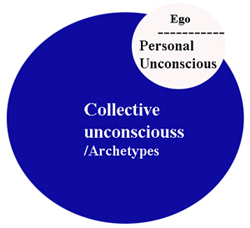Carl Jung > Resourcess
What is the Meaning of Collective Unconscious According to Jung
The collective unconscious is a psychic layer made of archetypes. It is common to all human beings regardless of culture and existential plane. We find it anywhere and
anytime. It is a hereditary datum that does not vary according to the level of intelligence, age, sex, etc. One can now acquire it only by way of culture and education.
Archetypes are innate tendencies, equally universal, which determine, beyond human consciousness, the basic activities and
their typical representations. We find them in dreams, in all cultural forms - in philosophical and religious images and concepts. In beliefs and aspirations.
Moreover, the archetypes regulate all essential human activities. Thus mother-child relationship is governed by the mother archetype. Father-child - by the father archetype.
Politics and public, social activities are regulated by archetypes.
The most important of all is the Self, which is the archetype of the Center of the psychic person, his/her totality or wholeness. Archetypes also appear in dreams and visions. Therefore the greatest deal of Jungian interest in psyche focuses on interpretation of dreams and symbols in order to discover the compensation
induced by archetypes as marks of psyche transformation during the analysis. Finally, we can describe the collective unconscious as a universal library accessible to all people or the wise (spirit) within man. Jung stated that the religious life must be linked with the experience of the archetypes of the collective unconscious. Thus, God himself is experienced like an archetype on the psychic, individual, level. What is an Example of Collective Unconscious? People use to ask for an example of collective unconscious. Obviously there'as no such example. You can't find an example of
collective unconscious just because this entity doesn't exist as a material piece of something. It is not something one can see and touch. It is a concept closer to psychology or philosophy. It doesn't have
a concrete shape. It exists only on the thinkin/thought plane. Jung Quote about the Collective Unconscious The collective unconscious - so far as we can say anything about
it at all - appears to consist of mythological motifs or primordial images, for which reason the myths of all nations are its real exponents. In fact, the whole of mythology could be taken as a
sort of projection of the collective unconscious... We can therefore study the collective unconscious in two ways, either in mythology or in the analysis of the individual. (From The Structure of the Psyche
, CW 8, par. 325.) Further Resources:
|
©AROPA, 2025.
